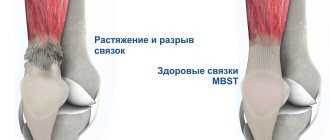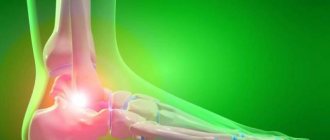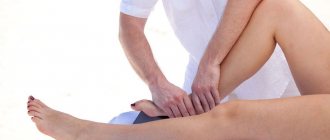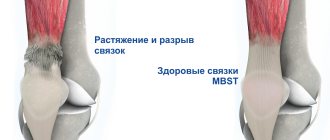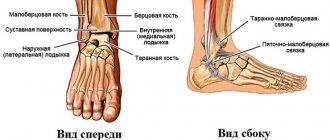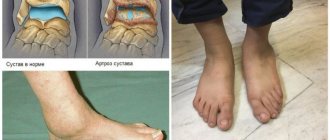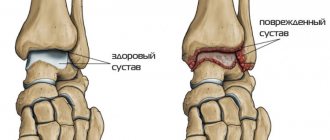Swollen ankles and swollen feet are a common symptom and are not very uncomfortable or a major cause for concern, especially if you have been standing or walking a lot. However, sometimes legs and ankles that remain swollen for a long time or are accompanied by other symptoms may indicate a serious problem in the body. The following article discusses some possible causes of foot and ankle swelling.
Causes of tumors
Static and dynamic loads place extreme stress on the lower limbs. When moving carelessly or performing twisting movements in the gym, dislocations often occur. The problem can also be caused by a compression fracture of the calcaneus, metatarsal or tarsal bones when falling from a height or having a strong impact. Displacement of the plantar bones, rupture of the joint capsule, ligaments lead to:
- to foot deformation;
- hemorrhage and hematoma;
- disruption of fluid outflow;
- increasing volume in the ankle area.
Achilles tendonitis
The disease appears due to inflammation of the synovial tendon sheaths and tissue degeneration after chronic overload of the calf muscles. Constant overexertion of the legs leads to severe swelling at the site of attachment of the tendon to the bone. The phenomenon is typical for professional athletes whose muscles are always in good shape.
In people 40-60 years old, this happens due to prolonged exposure to an uncomfortable position and physical inactivity. Due to the reduced range of motion, tendon rigidity, partial atrophy, and reduced mobility develop. In beginner athletes, when running or doing fitness, axial load injures the ligamentous apparatus.
Symptomatic treatment
Treatment of pain in the ankle should be carried out taking into account the root cause of the disease. Symptomatic therapy can alleviate the patient’s condition, but is only a temporary measure. For pain relief and to reduce inflammation, nonsteroidal anti-inflammatory drugs can be used in the form of tablets, injections, and ointments. After an ankle injury, it is recommended to apply cold (a heating pad with cold water, an ice pack) to reduce swelling and pain.
If possible, you should limit movements in the ankle; you should apply a fixing bandage while walking. At rest, the leg should be placed in an elevated position. Do not overload the joint (running, jumping, fast walking), or use warming compresses. Some conditions (injuries, synovitis) require urgent medical intervention, therefore, in case of deformation, pathological mobility (“looseness”), severe pain and swelling of the ankle, or an intense feeling of fullness, you need to call an ambulance.
Plantar fasciitis
If the joint is swollen, the problem is caused by inflammatory-degenerative changes in the fibrous tissue of the lower part of the foot. It is formed due to excessive external pressure when running on asphalt and pronation of the sole. Less commonly, a heel spur develops after traumatization by bone growths. The phenomenon is typical for obese people, in whom the anatomy of the tarsus and metatarsus changes under the weight of weight.
Orthopedic surgeon Andrey Yurievich Sidenkov comments:
Constantly wearing uncomfortable shoes and curvature of the outer arch also leads to tumors on both legs in women. Due to the increased load on the muscles, fluid does not have time to leave the intercellular space, which creates a local volume in the ankle area.
Gout
In 50% of cases, ankle problems arise due to specific diseases. Along with sprains and injuries, metabolic pathologies lead to problems with fluid removal. Inflammation of the big toe can be caused by a high concentration of uric acid in the blood. Instead of leaving with urine, it transforms into crystals and is deposited on the cartilage, causing swelling.
Arthritis
The disease is accompanied by a catarrhal process throughout the body, caused by infections, abnormalities in the immune system or metabolic disorders. With rare exceptions, arthritis of various etiologies develops in people of pre-retirement age.
- The cause may be psoriatic arthritis. It affects the fingers and toes; due to excess fluid in the tissues, it provokes an increase in volume.
- Septic is caused by the ingress of etiological agents - Staphylococcus aureus, Neisseria gonorrhoeae, gram-negative and positive aerobes, fungi.
- Swelling and long-term catarrhal process provoke rheumatoid arthritis. This is an autoimmune disease when healthy cells are affected due to failures in the defense system.
Anomalies of this kind include ankylosing spondylitis and systemic scleroderma. They are accompanied by specific symptoms inherent in each of them.
Diagnostics
The examination at the Yusupov Hospital includes laboratory diagnostics using modern equipment.
This is a complex of studies of body biomaterials, which allows you to refute or confirm the diagnosis and, as a result, establish the cause of the disease. After examination by a specialist, the patient is sent for a general urine test, biochemical and general blood tests. To exclude problems with the thyroid gland, hormone levels are determined.
The specialist draws up the entire range of diagnostic measures individually. If necessary, the patient may be referred for the following types of research:
- radiography;
- electrocardiogram (ECG);
- ultrasound examination (ultrasound);
- coagulogram;
- Ultrasound duplex scanning of blood vessels (USDS).
Based on research protocols and test results, the doctor selects the optimal treatment, which is aimed at eliminating the cause of swelling in the legs.
Arthrosis
Degenerative-dystrophic pathology occurs due to wear and tear of cartilage. Excessive loads lead to tissue destruction and inflammation, joint hypermobility syndrome. The anomaly occurs more often in young people:
- after injuries;
- accidents;
- with polyneuropathy or nerve damage;
- metabolic diseases.
Only 8% of all primary arthrosis develops for no apparent reason. When rising from a chair, a person feels pain, which disappears with movement. At the same time, the joints become swollen and lose stability and maneuverability. A person's gait changes, and a crunching sound is heard during movements.
Damage to venous valves and varicose veins
When movements occur in the vessels, negative pressure is created. With normal drainage, the blood flows downwards; if the valves are damaged, it goes into the superficial layers and sac-like dilates the vessels. Increased pressure in the veins weakens the tone of the walls, squeezes water into the soft tissues, which leads to fluid stagnation. Signs of venous disorders are heaviness in the limbs, discoloration of the skin, night cramps. Due to the dilation of the arteries, aching pain appears in the ankles.
Lymphostasis
Swelling in one or both legs causes disturbances in the outflow of lymph from the capillaries and peripheral nodes to the main collectors. It usually accumulates after traumatic occlusions, operations, or metastatic block of lymphatic vessels. Infections are often associated with the disease. In addition, there is a leakage of lymph through skin cracks and the appearance of tropical ulcers. Sometimes the disease is idiopathic in nature, and its origin cannot be determined.
There are other pathological factors that lead to tissue swelling in the ankle area. They are caused by abnormalities in the excretory, cardiovascular and endocrine systems. Problems arise due to liver pathologies, heart failure, hypothyroidism. If the cause is determined in time and ankle treatment is started, it is likely:
- stop the inflammatory process;
- destruction of bone tissue;
- maintain joint mobility;
- bring uric acid levels back to normal and restore purine metabolism.
When to contact specialists at Stoparthrosis Blades
The injury can be treated at home without pain. For more serious injuries, accompanied by acute pain and hyperemia, urgent medical care and diagnosis are necessary. If swelling and pain do not go away within 12 days after an injury, an examination by a specialized specialist is also necessary. If you contact an orthopedist and surgeon early, you have a better chance of a full recovery.
Our clinic employs vertebrologists, arthrologists, and traumatologists with 15 years of experience. They are ready to offer patients about 20 effective methods of non-surgical treatment of swelling of the ankle joints of various origins. Depending on the problem, patients are prescribed
- conservative schemes;
- hardware techniques;
- taping of ligaments;
- physiotherapy.
On the day of treatment, after the initial examination, doctors relieve acute sensations and prescribe instrumental diagnostics. To eliminate problems in older and younger people, in each case, specialists draw up an individual treatment plan.
How to get rid of ankle swelling?
, joint pain usually appears
Excess fluid accumulates in soft tissues and nearby muscles. The outflow of lymph and blood, especially venous, is disrupted. A person limits his movements in order to experience less discomfort. Although swelling is not always accompanied by pain. Sometimes it is only noticeable due to swelling in the joint area. The nature of the manifestation can be diffuse or local.
But in any case, examination cannot be avoided. The patient is sent for an x-ray, an ultrasound of soft tissues is performed, and an MRI of the joint is taken. Laboratory tests and diagnostic puncture will help determine the cause of the disease. If the situation is advanced, arthroscopy is mandatory. As part of this study, doctors drain the cavity of the affected joint.
Briefly about treatment
Two specialists will help you deal with excess swelling:
- Rheumatologist;
- Traumatologist-orthopedist.
They prescribe medication. The drugs eliminate pain and discomfort, inflammation and bacterial infection. Taking medications is combined with physiotherapy. Such procedures are designed to speed up the rehabilitation and restoration of joint function.
Why does the ankle joint swell?
This is not the only place prone to swelling. Soft tissues swell just below the knees, less often in the hip area. This is because it is in these places that the largest joints of the lower extremities are located. The knees and ankles bear a large load not only when moving, but also in static poses. When a joint becomes inflamed or injured, swelling most often occurs.
There are external and internal factors in the development of the disease. Soft tissues swell most often due to arthritis. Inflammatory and immune genesis of the joint leads to degeneration and ossification of cartilage tissue. There are several types of arthritis:
- Psoriatic. If psoriasis affects the toes, swelling occurs in the ankle area.
- Rheumatoid. A systemic autoimmune disease affects connective tissue. Pathological changes first affect small joints.
- Septic. Swelling occurs after an ankle injury and subsequent infection of the open cavity.
In addition to arthritis, other diseases that cause swelling are:
- Gout. Uric acid salts accumulate in the soft tissues, causing swelling. While walking, a sharp pain pierces the affected area.
- Bursitis. The synovial bursae become inflamed. The volume of exudate in the cavities increases noticeably.
- Plantar fasciitis. Inflamed connective tissue leads to swelling of the lower extremities.
- Elephantiasis. The functioning of the lymphatic system is disrupted.
- Problems with blood circulation. Lead to peripheral edema.
- Excess body weight. We are talking about stage 4 obesity.
- Soft tissue infection. The provocateurs are pathogenic microbes and viruses.
Swelling also occurs as a result of mechanical damage: dislocation, bruise, sprain, fracture.
How to cure the disease?
The goal of therapy is to improve blood circulation, increase the tone of veins, remove excess fluid from tissues, and reduce vascular permeability. If there was a fracture, you need to treat the wounds and compare the bone fragments.
Comprehensive treatment includes drug therapy and other treatment methods. The patient must follow a regimen, change his diet, and limit the load on the ankle. To relieve inflammation, doctors prescribe non-steroidal drugs, and analgesics to relieve pain. Treatment is impossible without antibacterial drugs. Sometimes it is impossible to do without hormonal therapy. Patients take vitamins. In exceptional cases, periarticular blockades and intra-articular injections of corticosteroids are performed.
Other treatment methods (carried out after taking medications) include:
- Physiotherapy;
- Massage;
- Therapeutic gymnastics;
- Sanitary resort treatment.
Author: K.M.N., Academician of the Russian Academy of Medical Sciences M.A. Bobyr
